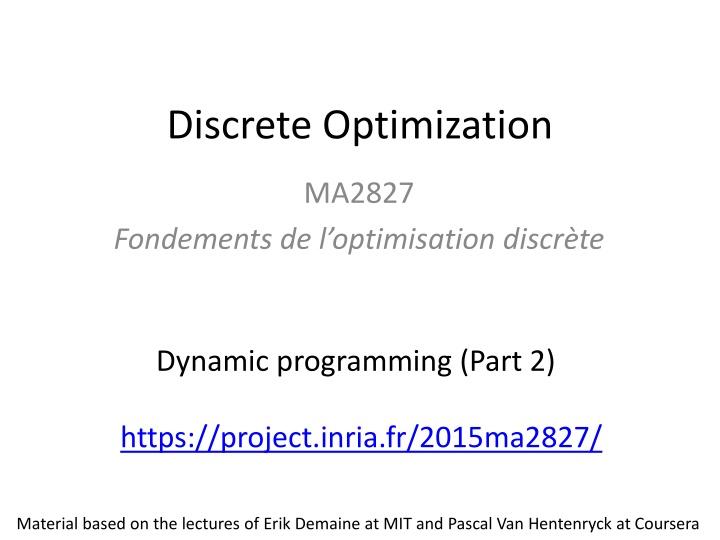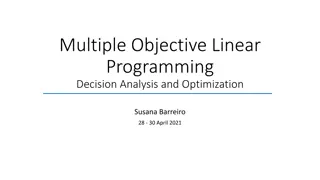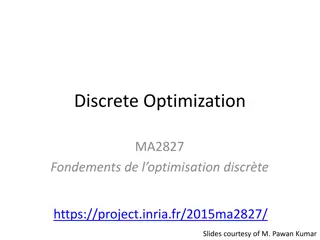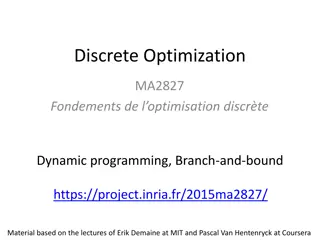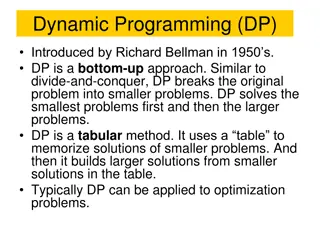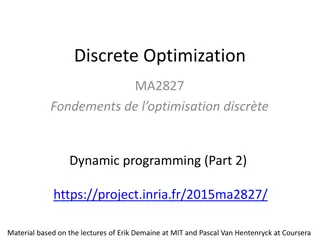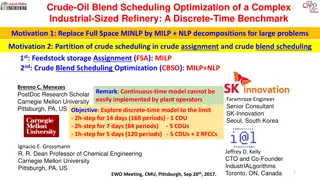Dynamic Programming Applications in Discrete Optimization: Tetris and Blackjack
Explore dynamic programming concepts in discrete optimization through practical applications like Tetris and Blackjack. Learn to optimize strategies for winning Tetris by placing pieces strategically and beat the dealer in Blackjack by making optimal decisions based on card values and rules.
Download Presentation

Please find below an Image/Link to download the presentation.
The content on the website is provided AS IS for your information and personal use only. It may not be sold, licensed, or shared on other websites without obtaining consent from the author.If you encounter any issues during the download, it is possible that the publisher has removed the file from their server.
You are allowed to download the files provided on this website for personal or commercial use, subject to the condition that they are used lawfully. All files are the property of their respective owners.
The content on the website is provided AS IS for your information and personal use only. It may not be sold, licensed, or shared on other websites without obtaining consent from the author.
E N D
Presentation Transcript
Discrete Optimization MA2827 Fondements de l optimisation discr te Dynamic programming (Part 2) https://project.inria.fr/2015ma2827/ Material based on the lectures of Erik Demaine at MIT and Pascal Van Hentenryck at Coursera
Outline Dynamic programming Guitar fingering More dynamic programming Tetris Blackjack
Quiz (as homework) Write the DP for perfect-information blackjack Derive the number of subproblems for the tetris problem
Tetris Task: win in the game of Tetris!
Tetris Task: win in the game of Tetris! Input: a sequence of n Tetris pieces and an empty board of small width w Choose orientation and position for each piece Must drop piece till it hits something Full rows do not clear Goal: survive i.e., stay within height h
Tetris Task: stay within height h Subproblem: survival? in suffix [ i : ] given a particular column profile #subproblems = O( n (h+1)w ) Guesses: where to drop piece i? #choices = O( w ) Recurrence: DP[ i, p ] = max { DP[ i + 1, q ] | q is a valid move from p } Base-case: DP[ n+1, p ] = true for all profiles p time/subproblem = O( w )
Tetris Task: stay within height h pieces Topological order: for i = n 1, n 2, , 0: for p = 0, , (h+1)w 1: profiles total time O( n w (h+1)w ) Final problem: DP[ 0, empty ]
Blackjack Task: beat the blackjack (twenty-one)!
Blackjack Task: beat the blackjack! Rules of Blackjack (simplified): The player and the dealer are initially given 2 cards each Each card gives points: - Cards 2-10 are valued at the face value of the card - Face cards (King, Queen, Jack) are valued at 10 - The Ace card can be valued either at 11 or 1 The goal of the player is to get more points than the dealer, but less than 21, if more than 21 than he looses (busts) Player can take any number of cards (hits) After that the dealer hits deterministically: until 17 points
Perfect-information Blackjack Task: beat the blackjack with a marked deck! Input: a deck of cards c0, , cn-1 Player vs. dealer one-on-one Goal: maximize winning for a fixed bet $1 Might benefit from loosing to get a better deck
Perfect-information Blackjack Task: beat the blackjack with a marked deck! Topological order: Subproblem: BJ( i ) = best play of ci, , cn-1 #subproblems = O( n ) Guesses: how many times player hits? #choices n Final problem: Recurrence: BJ( i ) = max{ outcome {-1, 0, 1} + BJ( i + 4 + #hits + #dealer hits ) | for #hits = 0, , n if valid play }
Perfect-information Blackjack Detailed recursion: def BJ(i): if n i < 4: return 0 (not enough cards) outcome = [ ] for p = 2, , n i 2: (# cards taken) player = ci + ci+2 + ci+4 + + ci+p+2 if player > 21: (bust) outcome.append( -1 + BJ(i+p+2) ) break for d = 2, , n i p 1 dealer = ci+1 + ci+3 + ci+p+2+ + ci+p+d if dealer 17: break if dealer > 21: dealer = 0 (bust) outcome.append( cmp(player, dealer) + BJ(i + p + d) ) return max( outcome )
Perfect-information Blackjack Task: beat the blackjack with a marked deck! Topological order: for i = n-1, , 0: Subproblem: BJ( i ) = best play of ci, , cn-1 #subproblems = O( n ) total time O( n3 ) Guesses: how many times player hits? #choices n Final problem: BJ[ 0 ] Recurrence: BJ( i ) = max{ outcome {-1, 0, 1} + BJ(i + 4 + #hits + #dealer hits ) | for #hits = 0, , n if valid play } time/subproblem = O( n2 )
